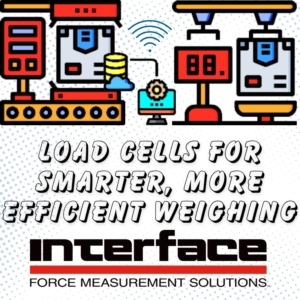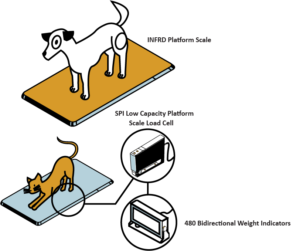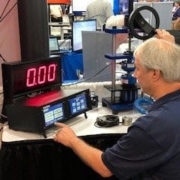Load Cells for Smarter and More Efficient Weighing
 Interface load cells are a key part of the advancements in weighing technologies. Breakthrough applications utilizing force sensing for weighing are expanding across industries. No matter the use case, weighing and scales must be trustworthy and always provide accurate information, as outlined in Accuracy Matters for Weighing and Scales.
Interface load cells are a key part of the advancements in weighing technologies. Breakthrough applications utilizing force sensing for weighing are expanding across industries. No matter the use case, weighing and scales must be trustworthy and always provide accurate information, as outlined in Accuracy Matters for Weighing and Scales.
For decades, load cells have been used for a wide range of weighing use cases. Load cells are electromechanical transducers that convert a force into an electrical signal. This electrical signal can then be amplified and processed to determine the weight of the object being weighed.
In testing or standard weighing practices, the load cell is typically mounted in a frame that supports the object being weighed. The load cell is connected to a signal conditioner, which amplifies the electrical signal from the load cell and converts it into a digital signal. The digital signal is then sent to a weighing controller, which calculates the weight of the object and displays it on a display. The weighing controller may also have additional features, such as data logging, remote monitoring, and programmable functions.
Now, Interface high accuracy load cells are found in advanced weighing applications used to define center of gravity for equipment, control inventory through weighing automation, batching, check weighing, process control and sample testing. Learn more about these applications and products in our Weighing Your Options Webinar.
Smart cities use connected force sensing trash receptacles for optimizing schedules of waste removal based on weight to reduce costs and increase efficiencies. Innovative smart pallet force sensing helps to track products and goods at the dock to reduce expenses and increase productivity using weight as the measurement. Silo weighing for inventory management uses setpoints that are configured to automatically generate purchase orders when product levels fall below a defined weight.
Weighing sensor technologies today are more than a standard measurement device. Interface load cells can measure across a wide range of force, from 0.02 to 2,000k lbf. As the types of applications mature in capabilities, innovation, and complexity, these requirements also help to define the type of sensors that will provide precision measurement.
Our weighing sensors combined with advanced instrumentation use a variety of communication methods, including analog, digital, wireless and cloud based, to allow users to gather data in-facility or remotely. We can customize sensors to meet specifications for weighing use cases, including the design of complete weighing systems.
Advanced weighing applications often require sealed sensors with submersible features, wireless output and communications capabilities, and ease of use to design into products, machines or equipment.
Digital scales with advanced features such as data logging, connectivity options, and programmable functions have become commonplace. From bench scales to platform scales, there is a diverse way for our load cells to be implemented and available to measure diverse types of weighing applications.
Popular Interface Products Used for Weighing Applications
- Platform Scale Load Cells
- Load Shackles
- Load Pins
- Tension Link and Wireless Link Load Cells
- Pillow Block Load Bearing Load Cells
- WeighCheck™ Load Cells
- LowProfile® Load Cells
- Load Beam Miniature Load Cells
- Weighing Digital Indicators and Instrumentation
- Junction Boxes
- Wireless and Bluetooth Sensors, Systems and Accessories
Load cells are an essential part of many weighing applications. They are used to measure the weight of objects in a variety of industries, including manufacturing, food processing, and logistics. Load cells provide accurate and reliable measurements, which is essential for ensuring the quality and safety of products.
WeighingSolutions_InfographicPosterLearn more in the application note details below.
 Veterinary Weighing Scales
Veterinary Weighing Scales
A manufacturer wanted two weighing scales for consumers like veterinarians who want to weigh large and small animals. Interface suggested using two different solutions. For the smaller scale, Interface’s SPI Low Capacity Platform Scale Load Cell was perfect for smaller, and lighter animals. As for the larger scale, the INFRD Platform Scale with pre-installed load beams worked best. Both scales included 480 Bidirectional Weight Indicators to display the total weight of the animals being weighed. Using this solution, the veterinarian was able to weigh both large and small pets easily and accurately with both scales.
Silo Grain Weighing and Dispensing
A customer wanted to measure and record the grain being put in and out of their grain dispensing container, as it dispenses content into a carrier truck for transportation. Interface suggested a wireless solution, installing a WTS 1200 Standard Precision LowProfile™ Wireless Load Cells at the legs of the grain dispensing container. The 1200 measured the distribution correlation of the grain as it inputted and outputted from the container. Results were transmitted and displayed using the WTS-BS-1-HA Handheld Display for multiple transmitters, and logged and graphed using the WTS-BS-4 USB Industrial Base Station. With this solution, the customer was able to log and graph the measurement results of the grain content that the silo dispenses into the grain dispensing container, and when the grain is dispensed into the carrier truck.
Weighing is among the oldest use cases for load cells in the world and Interface has been there nearly every step of the way, growing alongside our customers and developing new innovations to perfect accuracy, reliability and durability. To learn more about our sensor solutions for weighing application, please visit https://www.interfaceforce.com/solutions/weighing-solutions/.








